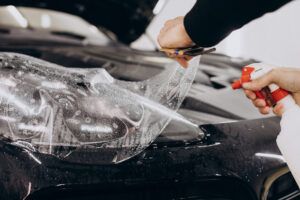Picture this: You’re cruising down Interstate 15 through Utah Valley, the Wasatch Mountains towering beside you, and suddenly you wish you could feel that crisp mountain air and see those peaks without craning your neck out the side window. That’s when it hits you – your car needs a sunroof.
But here’s where most people slam on the brakes. “Won’t that void my warranty?” they ask, worried about protecting their investment. The good news? You can absolutely add a factory-quality sunroof to your vehicle without kissing your warranty goodbye. The key lies in understanding how warranties work and choosing the right installation approach.
Understanding Your Vehicle Warranty and Aftermarket Modifications
Your vehicle warranty isn’t as fragile as you might think. Thanks to the Magnuson-Moss Warranty Act of 1975, manufacturers can’t simply void your entire warranty because you added an aftermarket part. They must prove that your modification directly caused any failure they’re refusing to cover.
Think of it like renovating your house. Installing a skylight doesn’t void your roof warranty unless that skylight causes a leak. The same principle applies to your vehicle. A professionally installed sunroof won’t affect your engine warranty, transmission coverage, or most other vehicle systems.
However, the installation quality matters tremendously. A botched sunroof job by an inexperienced installer could lead to water leaks, electrical issues, or structural problems. That’s why choosing certified professionals who specialize in OEM-quality installations becomes your insurance policy for maintaining warranty protection.
The Professional Installation Advantage
When you walk into a dealership service department, they’ll often tell you that any modification voids your warranty. But here’s what they’re not telling you: dealerships themselves often outsource sunroof installations to specialized shops. These same shops can provide you with factory-equivalent installations at a fraction of the dealer markup.
Professional sunroof installers use the same Webasto or Inalfa units that come as factory options on many vehicles. These aren’t the leaky, aftermarket units from decades past. Modern aftermarket sunroofs incorporate the same technology, drainage systems, and safety features as factory installations. The installers follow manufacturer-specific procedures, ensuring proper integration with your vehicle’s electrical system, interior lighting, and even maintaining the structural integrity of your roof.
In Utah’s unique climate, with our hot summers and snowy winters, professional installation becomes even more critical. Temperature extremes can expose poor workmanship quickly. Water intrusion from melting snow or summer thunderstorms will find any shortcuts in the installation process. Certified installers understand these challenges and use appropriate sealants, gaskets, and installation techniques designed for our four-season climate.
Choosing Between Standard and Panoramic Sunroof Options
The sunroof market has evolved dramatically. No longer limited to small pop-up vents or basic sliding panels, today’s options rival anything available from the factory. Standard sunroofs typically measure around 16 by 32 inches, perfect for bringing light and air into the front seats. But if you’re dreaming bigger, panoramic sunroof installation Utah specialists can transform your entire roof into a glass showcase.
Panoramic installations have become increasingly popular, especially in SUVs and crossovers where rear-seat passengers want to enjoy the view. These expansive glass panels can stretch nearly the entire length of your roof, creating an open-air feeling throughout the cabin. Some models include separate controls for front and rear sections, allowing passengers to customize their experience.
Cost considerations vary significantly between standard and panoramic options. A standard sunroof installation typically runs between $1,000 and $2,000, including parts and labor. Panoramic installations can range from $2,500 to $4,000, depending on your vehicle’s complexity and the specific system chosen. While the panoramic option costs more upfront, many owners find the dramatic transformation worth the investment, especially here in Utah where our scenic drives deserve a proper viewing platform.
Selecting a Certified Installer in Utah
Finding the right installer can make or break your sunroof project. Utah has several shops specializing in automotive glass and sunroof installations, but not all offer the same level of expertise or warranty protection. Start by looking for shops certified by major sunroof manufacturers like Webasto, Hollandia, or ASC. These certifications indicate proper training and access to OEM-quality components.
Ask potential installers about their warranty offerings. Reputable shops provide comprehensive warranties covering both parts and labor, often matching or exceeding factory coverage periods. They should also offer documentation stating that their installation maintains your vehicle’s original warranty – this paperwork becomes crucial if you ever need warranty service at a dealership.
Check their installation process. Professional shops use laser measuring tools to ensure precise cuts, maintain factory drainage channels, and properly integrate with your vehicle’s electrical systems. They should explain how they’ll maintain your roof’s structural integrity and prevent common issues like wind noise or water leaks. Don’t hesitate to ask for references or examples of completed work on vehicles similar to yours.
Maintaining Your Warranty Documentation
Paperwork might seem boring, but it’s your best defense against warranty disputes. When you have a sunroof professionally installed, collect every piece of documentation. This includes the installation invoice, warranty certificates, and any statements about maintaining your factory warranty. Create digital copies and store them both in your vehicle’s glove box and in a secure location at home.
Professional installers understand this importance and typically provide comprehensive documentation packages. Quality shops will even contact your dealer on your behalf to confirm that their installation won’t affect your warranty coverage. Some go further, offering to handle any warranty disputes that might arise from their work.
Keep records of all maintenance performed on your sunroof too. Regular cleaning of drainage tubes, lubricating tracks, and replacing weatherstripping as needed shows you’ve properly maintained the modification. This proactive approach further protects your warranty position and extends the life of your sunroof investment.
Special Considerations for Utah’s Climate
Utah’s unique geography creates specific challenges for sunroof installations. Our elevation means stronger UV exposure, requiring high-quality glass with proper UV protection. Summer temperatures in St. George can exceed 110 degrees, while Park City sees heavy snow loads each winter. These extremes demand installation techniques adapted to our environment.
Professional installers in Utah understand these challenges. They use sealants rated for extreme temperature swings and ensure drainage systems can handle rapid snowmelt. They’ll also recommend appropriate glass tinting to reduce heat buildup during summer months while maintaining visibility for those stunning mountain views.
Many Utah installers offer seasonal maintenance packages, checking seals before winter and clearing drainage channels after spring pollen season. This regional expertise provides peace of mind that your sunroof will perform reliably whether you’re exploring the red rocks of Moab or navigating a snowstorm in the Cottonwood Canyons.
The investment in a quality sunroof installation pays dividends every time you drive. Whether it’s catching the alpenglow on Mount Timpanogos during your evening commute or giving your kids a view of the stars while camping in Capitol Reef, a properly installed sunroof enhances every journey. And when done right, with professional installation and proper documentation, you’ll enjoy these benefits without sacrificing your warranty protection.
Remember, your vehicle is likely one of your largest investments. Protecting that investment while enhancing your driving experience isn’t just possible – it’s smart financial planning. Choose quality components, professional installation, and maintain proper documentation. Do these things, and you’ll enjoy the best of both worlds: the open-air freedom of a sunroof and the security of full warranty coverage.
Frequently Asked Questions
Q: How long does professional sunroof installation typically take?
A: Most standard sunroof installations can be completed in 4-6 hours, while panoramic sunroof installation Utah shops typically need 6-8 hours. The installer should provide your specific timeline based on your vehicle model and chosen sunroof type.
Q: Will my insurance rates increase after adding a sunroof?
A: Generally, insurance rates don’t increase for professionally installed sunroofs. However, you should notify your insurance company of the modification and may want to increase your comprehensive coverage to reflect the added value of your vehicle.
Q: Can I install a sunroof in a leased vehicle?
A: Lease agreements typically prohibit permanent modifications. However, some leasing companies allow sunroof installations if performed by certified professionals. Always check your lease terms and get written permission before proceeding with any modifications.
Q: What’s the difference between a moonroof and a sunroof?
A: While often used interchangeably, technically a moonroof is a glass panel that may tilt or slide open, while a traditional sunroof might be an opaque panel. Today, most “sunroofs” are actually glass moonroofs that provide both light and ventilation options.
Q: How often should I maintain my aftermarket sunroof?
A: Professional installers recommend cleaning and lubricating your sunroof every 3-4 months, with more frequent attention during Utah’s pollen season. Annual professional inspections help catch potential issues before they become warranty concerns.



